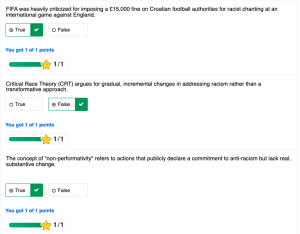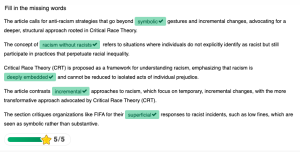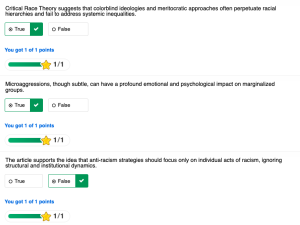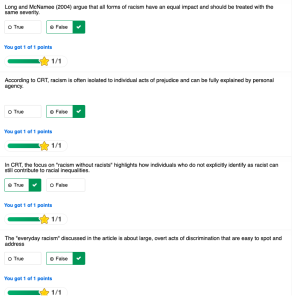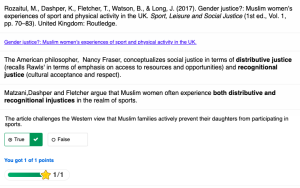3
Section One: The Fundamentals
A) Keywords
Exercise 1:
Briefly (in 100 words or less) define one of the keywords in the padlet (including one that you. may have added yourself).
| Critical race theory is the idea that society holds a racial bias that is embedded within western society. This is implemented through the legal and social levels as these institutions were created and controlled by primarily white people, who push their own views onto others. |
Padlet Response
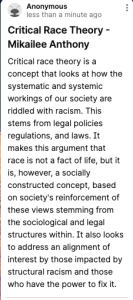
B) Representing Race
Exercise 2: Notebook Prompt
In about 50-70 words, consider Joel Bevel’s question: why do we feel the need to extrapolate the athleticism of one Black athlete to all Black people when we do not do the same for white athletes?
Try to think of examples when this happens, making sure to reflect on your own positionality.
| I believe that society attributes physical variations for the success of Black people versus the attributions of hard determination they tie to white people’s success as a symptom of an implicit bias. For example, Tom Brady’s success is attributed to his quick thinking and dedication, whereas Usain Bolt is credited for his physical build. I was not aware of this bias in myself and will strive to do better.
|
C) Gender, Race & Sport
Exercise 3: Notebook Prompt
What are some strategies for resistance that Rajack and Joseph identify in their article as a means of pushing back against and resisting misogynoir?
| One of the strategies for resistance outlined by Razack and Joseph is self-representation. An example of self-representation is Naomi Osaka, who identifies with the mainstream categories, such as “Black, Asian, mixed, Japanese, American, and/or Haitian” (Razack, 2021). However, Osaka “complicates her self-representation often choosing multiple categories” (Razack, 2021). By using self-representation, Naomi is able to show the public “the fluidity of her identities and reinforce the ideology that racial, cultural, and national identities are never fixed” (Razack, 2021). Naomi uses “ self-representation [as] an act of resistance to the mainstream media, which often conflate, erase or are unable to address the complexities of her identities” which has caused “incremental shifts in some mainstream articles do signify potential ruptures and counter-narratives” (Razack, 2021). Another method of resistance is broadening the definitions that we are used to. Within the article, the authors mention “George Dei’s recent article: “Black Like Me: Reframing Blackness for Decolonial Politics,” he urges academics to broaden their definitions of Blackness” (Razack, 2021). This means that we “must cultivate resistant knowledge that challenges our colonial complicities” (Razack, 2021). This new way of think would show that being ‘black’ is not a singular identity, but rather a multitude and diverse identity. As a form of resistance, we must show blackness as an identity with a wide range of qualities, as opposed to colonial perpetuations.
References Razack, S., & Joseph, J. (2021). Misogynoir in women’s sport media: race, nation, and diaspora in the representation of Naomi Osaka. Media, Culture & Society, 43(2), 291-308. https://doi-org.proxy1.lib.trentu.ca/10.1177/0163443720960919 |
Section Two: Making Connections
A) Athlete Activism
Exercise 3: Padlet Prompt
Do athletes have a responsibility to use their platform for social change? Why or why not? Please remember to record your response in both the padlet below and in your Notebook.

Padlet Response: I do believe that athletes have a responsibility to use their platform for social change. This is firstly because they have the platform to do so. Because people idolize and respect athletes, they will be more receptive to hearing what they have to say. With such large followings, athletes can spread positive change on a larger scale. Also, a lot of people feel as though their outlooks and characteristics are similar to athletes, so if their favourite athlete speaks out on something, their followers are more inclined to listen. Also, athletes have the ability to educate large numbers of people at a wide variance of subtypes at once. For example, an athlete may have followers that consist of all ages; some who don’t watch the news some who watch every day, some who are very ingrained in a political party, and some who have no affiliation at all. This creates a great place to reveal and share crucial information. As a final note, sports have a heavy influence on culture, and culture has a heavy influence on society’s values. Athletes are the starting point of a wave of change, so not using their platforms to do so would be a massive waste of an opportunity and could set us years behind on progress.
B) Athlete Activism & Feminism
Exercise 4: Complete the activities
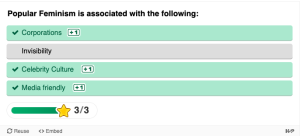
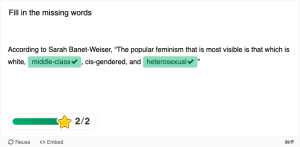
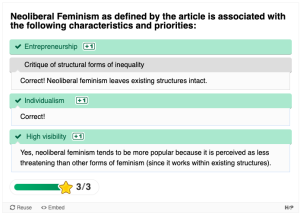
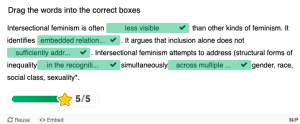
Exercise 5: Notebook Prompt
What do the authors of the article call for as a way of challenging how mainstream sports journalism privileges neoliberal feminist concerns? (100 words max.)
| The authors of this article call for a change in “sports media scholars to tell stories differently” (Cooky, 2020), as a form of activism. It highlights that “narratives of solidarity and collectivism are informed by articulations of intersectional and neoliberal feminisms” (Cooky, 2020). Furthermore, by telling stories differently, it “[disrupts] the boundaries of what constitutes sports media and challenging epistemological hegemonies of sports media research allow for different ways of knowing to emerge” (Cooky, 2020). Therefore, it boils down to simply ‘telling stories differently’ in order to challenge how mainstream sports privileges neoliberal feminist concerns” (Cooky, 2020). |
C) Corporate social justice
Exercise 6: Padlet Poll
| Original post:
In favour:
Response to classmate: Hi there, I think your point about it not being the individual athlete’s job to advocate is really interesting. I completely agree with you that it should be their choice, however, I fear that public pressure may cause more backlash in the long run. Not speaking up may cause people to jump to their own conclusions on what they think that specific athlete believes, which could cause a lot of hate. I’m not sure what a solution is. Possibly having a representation for the team who speaks on everyone’s behalf could work, however, that representative may not take all concerns into consideration either. |
Section Three: Taking a shot
Module Assignment (submit as part of notebook and separately through Blackboard mini assignment #1 portal)
What strategies do athletes employ to speak out?
Within film 42, based on the story of Jackie Robinson entering the baseball league as the first black player, Jackie Robinson employs a few different strategies of speaking out that don’t necessarily involve using his voice. The first manner in which Jackie ‘spoke out’ was by employing silence. When being verbally accosted during the game against Philadelphia by Ben Chapman, Jackie Robinson remained quiet. Ben Chapman worked hard to get Robinson to retaliate so he could be painted poorly by the media and removed from the game, but Jackie remained silent. This became a strategy for Jackie within the game and outside of the game. He refused to let the media and those against him force him into a narrative that would further the prejudice and racism he experienced. Another strategy used by Jackie Robinson that was evident within this film is how he used his abilities to challenge the stereotypes and the racially based blockages that existed within baseball, which were a reflection of the social climate at the time. This strategy was a suggestion of Branch Rickey, who was the Brooklyn Dodgers executive manager. When he told Robinson he would put him in the tryouts for the major league teams, Rickey told him “There’s one condition…[he] wants a player who’s got the guts not to fight back” (Helgeland et al., 2013, 11:19). Rickey makes it clear that if Robinson wants to succeed, he needs to remain resilient through self-discipline, and show them who he is by showing them how well he can play. This was employed as a merit-based strategy that forced those against Jackie Robinson to see who he was as a player. While this form of activism is not typical as it was not as direct in speaking out against the issues, it was certainly effective in breaking down such barriers as people saw Jackie for who he was, not his skin colour.
What is the commentary on athletes using their voices in these shows?
There are very mixed reactions to Jackie Robinson’s presence in the major league baseball world. Because of the portrayal of Jackie Robinson, and any person of the Black community, at the time, allowed people’s prejudices to fester as “issues of race, ethnicity, and national identities are, of course, deeply interwoven [into media], at some times and in specific contexts more so than at others” (Boyle, 2012). A great example of the poor commentary coming to light is when the old man goes to the house where Jackie Robinson is staying. He tells the people sitting on the porch that he won’t be the only angry person showing up, and that at dawn, they should expect a mob of angry people because Jackie Robinson should not be allowed to participate due to his skin colour. This example shows how “sport serves as a site where societal inequalities such as racism, sexism, economic stratification, and other forms of oppression are reproduced, exacerbated, and/or ignored” (Galily, 2019). This furthers the representation of poor response of Jackie doing something as small as participating in a sport, which led to the polarization of his position. On the flip side, when Jackie and his wife are walking around, a white man approaches him and says that he is rooting for Jackie to win, as he sees potential in him and wants the segregation of sports to end. Thus, as mentioned in the journal about Lebron James, how his speaking out was rather polarizing at the time, which is similar to Jackie Robinson’s participation in Baseball. People were not willing to hear other perspectives or change their minds due to such a polarizing topic as “in times of political polarization when exposure to cross-cutting discourse is missing, people are far less likely to perceive opposing standpoints as legitimate, and less able to provide a rational explanation to their own political decisions”(Galily, 2019). Therefore, the commentary on Jackie Robinson’s presence as a form of activism was a controversial topic, leading to responses that were either extremely in favour of him or responses that were not in favour.
How do race and/or gender or other identities inform this representation?
Race plays a crucial role within the film 42, as it is a physical representation of the segregation and racism prevalent during this time. Oftentimes, Jackie Robinson was not accepted by the white athletes on his team. We see this initial aversion to Robinson on behalf of the white team members when Jackie is joining the Brooklyn Dodgers. The team got together and wrote a letter outlining their disdain for Jackie, and their protest against playing with a Black person in a primarily white sport (at the time). To express their disdain to do so, each member signed a letter saying they would refuse to play the game if Jackie Robinson was placed on their team. This shows how race was a crucial determinator in the welcoming of Jackie, as he was a very skilled player, who only offered benefits to the team, yet the white players could not get past his race as a black man, causing them to give their coach an ultimatum, which ultimately did not benefit them as Jackie still joined the team. Another identity within the film that informs the representation of Black players is the contrast of those against him. While many white people fought with aggression through their words and actions against Robinson’s involvement in the sport, many black and white people supported him and saw his presence as revolutionary. An example of this is when Jackie is speaking with his coach, and his coach tells him about a young white boy he saw, who was pretending to be like Jackie, as he similarly swung his bat. This highlights how Jackie not only became an inspiration to people of the same background but also to those who were of different physical and social classes. It embodies his courage and how he broke through the racial barriers that existed, thus illustrating how he became an identity that represented the removal of segregation.
How do these representations shape how we understand the sports themselves?
I believe that sports are a playing ground for change. These representations allow society to reconsider their beliefs and opinions, as sports are a place where all that should matter is your skill, nothing else. As previously mentioned, “sport serves as a site where societal inequalities such as racism, sexism, economic stratification, and other forms of oppression are reproduced, exacerbated, and/or ignored” (Galily, 2019). This means that sports can be used as a reflection of where we stand as a society. It shows where we need to improve, which allows each individual to reflect inward and ask ourselves why we feel or think the way that we do. This idea is represented throughout the film 42, as Jackie Robinson eventually wins over his team and the crowds as they can’t deny his skill and talent. Because of Jackie’s hard work and determination, he changed the way people looked at sports. Something that was segregated because over time as we see today, arenas are filled with many sorts of people. While this is true, there are still many issues that exist within sports. However, because of Jackie Robinsons efforts, we now know that it is possible to make change. We can use sports and athletes to assess and adjust our beliefs and commonly used systems to point out the flaws that exist within our world. Thus, these representations within move 42 about Jackie Robinson help us use sports to understand and continually improve, and Jackie showed us this is possible.
References
Boyle, Raymond, and Richard Haynes, ‘The Race Game: Media Sport, Race and Ethnicity’, Power Play: Sport, the Media and Popular Culture (Edinburgh, 2009; online edn, Edinburgh Scholarship Online, 20 Sept. 2012), https://doi.org/10.3366/edinburgh/9780748635924.003.0006, accessed 22 Feb. 2025.
Galily, Y. (2019). “Shut up and dribble!”?athletes activism in the age of twittersphere: The case of Lebron James. Technology in Society, 58, 101109. https://doi.org/10.1016/j.techsoc.2019.01.002
Warner Bros. (2013). 42. United States.

